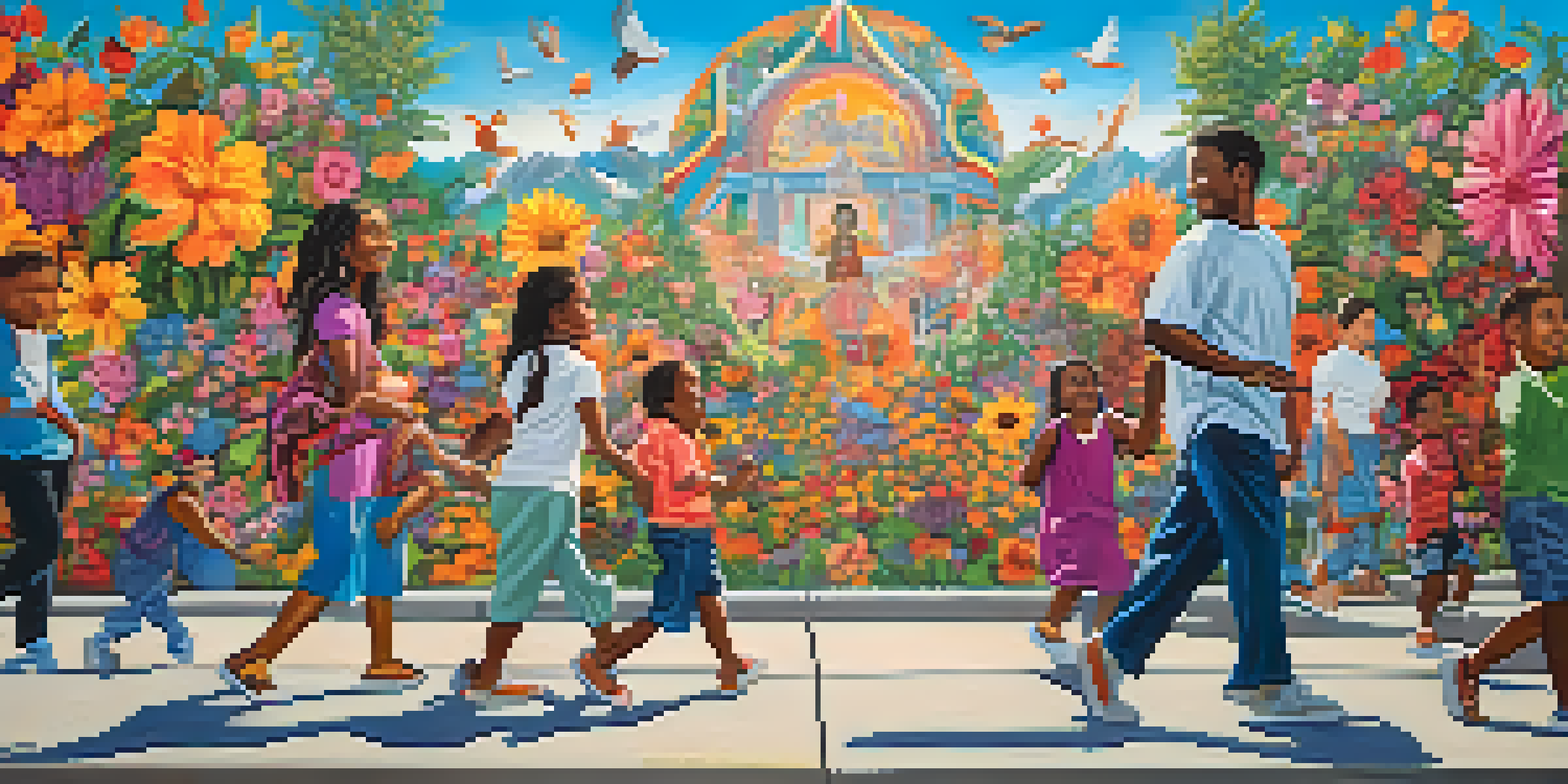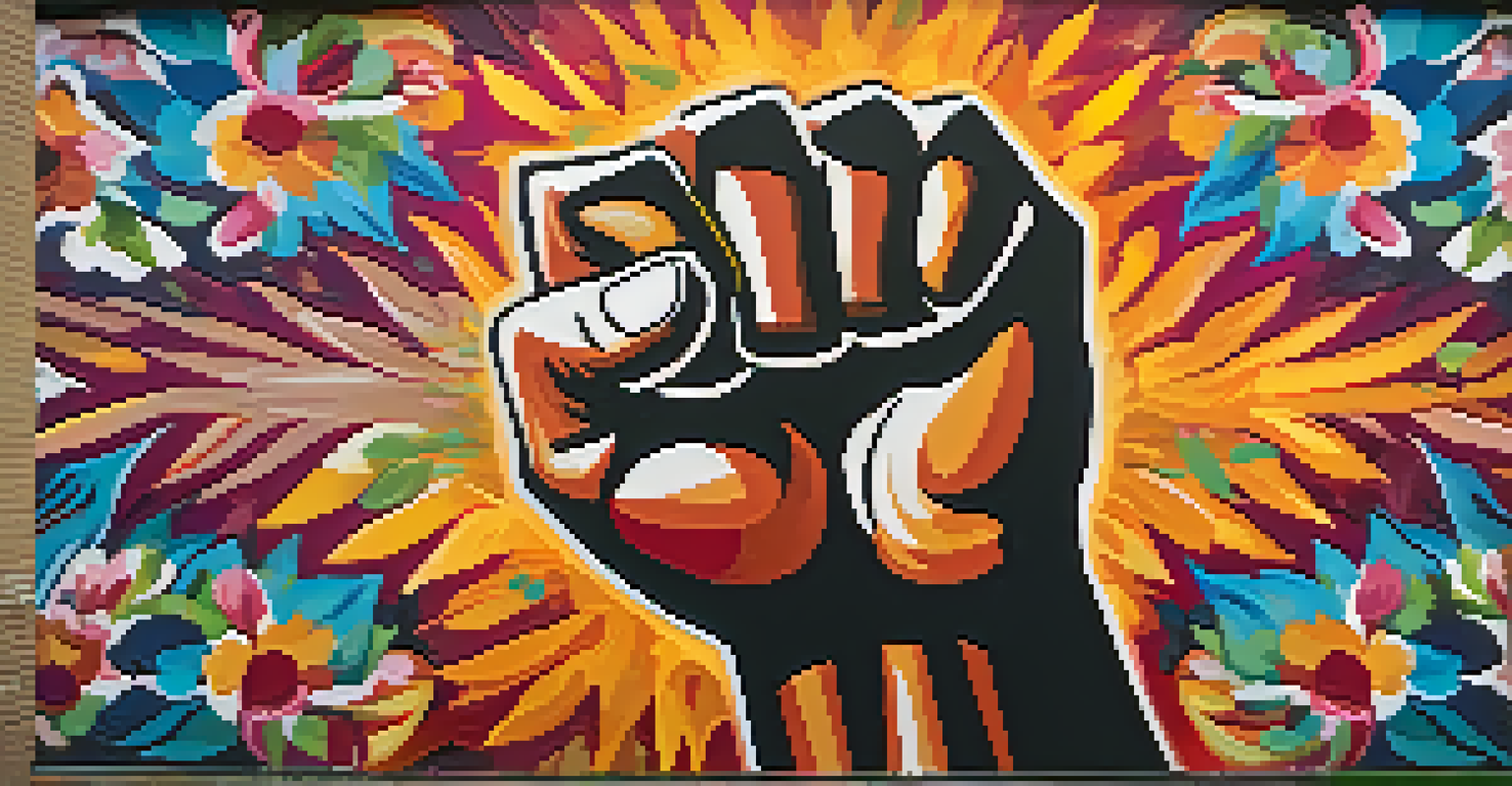Street Art: A Canvas for Political Protest and Expression

The Rise of Street Art as a Political Tool
Street art has transformed from mere graffiti to a powerful medium for political expression. Artists use walls as canvases to convey messages that resonate with local communities, often addressing societal issues. This evolution reflects a broader shift in how art interacts with politics, showing that creativity can be a form of resistance.
Art is the most beautiful of all lies.
From the vibrant murals of Mexico to the poignant pieces in Berlin, street art varies greatly across cultures but shares a common thread of activism. Artists like Banksy have gained global recognition, proving that their work can influence public discourse. Such visibility amplifies the messages behind the art, making them accessible to a wider audience.
Moreover, street art often emerges in response to specific events or movements, making it a timely reflection of societal sentiments. For instance, during protests, artists take to the streets to create pieces that capture the essence of the moment, ultimately fostering community solidarity and awareness.
Expressing Identity Through Urban Art
Street art frequently serves as a reflection of cultural and personal identity. Artists draw from their backgrounds and experiences to create works that resonate with their communities, which can foster a sense of belonging. This expression can take many forms, from traditional motifs to contemporary styles that challenge the status quo.

In many urban areas, street art becomes a visual narrative of the collective identity, documenting struggles and triumphs. For example, in neighborhoods with rich histories, murals can tell stories of resilience and hope, connecting past generations with the present. This connection not only honors heritage but also inspires future generations.
Street Art as Political Expression
Street art serves as a powerful medium for political activism, enabling artists to address societal issues and resonate with local communities.
Furthermore, street art can also challenge stereotypes and misconceptions by offering alternative perspectives. Through their work, artists can highlight issues such as racial inequality or gender discrimination, sparking conversations that might not occur otherwise. This dialogue is essential for fostering understanding and empathy within diverse communities.
Street Art as a Reaction to Social Injustice
Many street artists respond directly to social injustices through their work, making bold statements that resonate with the public. For instance, during the Black Lives Matter movement, countless murals emerged depicting powerful messages of solidarity and change. These pieces often go viral, spreading awareness beyond local communities.
The role of the artist is to ask questions, not to answer them.
The immediacy of street art allows artists to react swiftly to current events, making it a potent tool for activism. Unlike traditional forms of art that may take time to create and exhibit, street art can be produced and shared in a matter of hours. This ability to adapt and respond makes it an invaluable medium in times of crisis.
Additionally, street art can provoke thought and inspire action, encouraging viewers to engage with pressing societal issues. By placing these artworks in public spaces, artists invite dialogue and reflection, prompting individuals to consider their roles in addressing these injustices. This interaction is crucial for fostering a more aware and active society.
The Role of Technology in Street Art
In today's digital age, technology plays a significant role in the evolution of street art. Social media platforms allow artists to share their work instantly, reaching a global audience and garnering support for their messages. This connectivity has revolutionized how street art is perceived and appreciated.
Moreover, technology has introduced new techniques and tools for creating street art. From digital murals to augmented reality, artists can experiment with innovative forms that enhance their messages. This fusion of technology and artistry expands the possibilities for expression in public spaces.
Cultural Identity Through Art
Artists use street art to reflect and celebrate cultural and personal identities, fostering a sense of belonging within their communities.
Additionally, the documentation of street art online ensures that these temporary works can be preserved for future generations. Photographs and videos shared on social media create a lasting archive of movements and messages, allowing the art to continue its impact even after the physical piece has faded away.
Challenges Facing Street Artists Today
While street art serves as a powerful form of expression, artists often face significant challenges. Legal issues surrounding graffiti can lead to arrests and fines, stifling creativity and limiting opportunities for artists. This tension between artistic freedom and legal constraints poses a dilemma for those who wish to share their messages publicly.
Furthermore, the commercialization of street art can dilute its original intent. As major corporations capitalize on the movement, some artists express concern that their work is being co-opted for profit rather than genuine activism. This raises questions about authenticity and the true purpose of street art in society.
Lastly, the ever-changing urban landscape poses a threat to street art's permanence. Many murals are painted over or destroyed as neighborhoods evolve, which can be disheartening for artists who invest their time and energy into their work. Despite these challenges, the resilience of street artists continues to shine through.
Global Perspectives on Street Art and Politics
Street art's political significance can be seen around the globe, with each region offering unique perspectives. In places like Tunisia and Egypt, artists have used public walls to express dissent and celebrate freedom, especially during the Arab Spring. These works serve as powerful reminders of the struggles for democracy and human rights.
In contrast, in countries like North Korea, street art is heavily controlled, with artists facing severe repercussions for dissenting voices. This stark difference highlights how the political climate can shape artistic expression, often serving as a barometer for freedom and oppression. The restrictions faced by artists in such environments emphasize the bravery of those who choose to speak out through their work.
Challenges for Street Artists
Despite its impact, street artists face legal challenges and commercialization, which can hinder their ability to express genuine activism.
Ultimately, the global landscape of street art reflects the diverse experiences and challenges faced by communities. Despite varying circumstances, the underlying theme of resistance and expression remains constant, reinforcing the idea that art can transcend borders and unite people in their quest for justice and change.
The Future of Street Art as Political Expression
As societal issues continue to evolve, so too will the role of street art in political expression. Emerging technologies, such as virtual reality and interactive installations, may provide new avenues for artists to convey their messages. This innovation could further engage audiences and spark meaningful conversations about pressing topics.
Moreover, as more individuals recognize the impact of street art on social movements, we may see increased support for artists and their work. Communities might band together to protect murals and support public art initiatives that promote dialogue and awareness. This potential for community engagement could strengthen the bond between art and activism.

Ultimately, the future of street art as a political medium will depend on the ongoing dialogue between artists and their communities. As long as artists continue to use their voices to address important issues, street art will remain a vital form of expression that resonates with audiences worldwide.